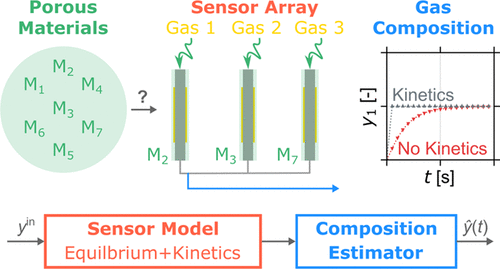Our official English website, www.x-mol.net, welcomes your
feedback! (Note: you will need to create a separate account there.)
Material Screening for Gas Sensing Using an Electronic Nose: Gas Sorption Thermodynamic and Kinetic Considerations
ACS Sensors ( IF 8.2 ) Pub Date : 2021-10-13 , DOI: 10.1021/acssensors.1c01807 Ashwin Kumar Rajagopalan 1 , Camille Petit 1
ACS Sensors ( IF 8.2 ) Pub Date : 2021-10-13 , DOI: 10.1021/acssensors.1c01807 Ashwin Kumar Rajagopalan 1 , Camille Petit 1
Affiliation

|
To detect multiple gases in a mixture, one must employ an electronic nose or sensor array, composed of several materials, as a single material cannot resolve all the gases in a mixture accurately. Given the many candidate materials, choosing the right combination of materials to be used in an array is a challenging task. In a sensor whose sensing mechanism depends on a change in mass upon gas adsorption, both the equilibrium and kinetic characteristics of the gas–material system dictate the performance of the array. The overarching goal of this work is twofold. First, we aim to highlight the impact of thermodynamic characteristics of gas–material combination on array performance and to develop a graphical approach to rapidly screen materials. Second, we aim to highlight the need to incorporate the gas sorption kinetic characteristics to provide an accurate picture of the performance of a sensor array. To address these goals, we have developed a computational test bench that incorporates a sensor model and a gas composition estimator. To provide a generic study, we have chosen, as candidate materials, hypothetical materials that exhibit equilibrium characteristics similar to those of metal–organic frameworks. Our computational studies led to key learnings, namely, (1) exploit the shape of the sensor response as a function of gas composition for material screening purposes for gravimetric arrays; (2) incorporate both equilibrium and kinetics for gas composition estimation in a dynamic system; and (3) engineer the array by accounting for the kinetics of the materials, the feed gas flow rate, and the size of the device.
中文翻译:

使用电子鼻进行气体传感的材料筛选:气体吸附热力学和动力学考虑
要检测混合物中的多种气体,必须使用由多种材料组成的电子鼻或传感器阵列,因为单一材料无法准确解析混合物中的所有气体。鉴于有许多候选材料,选择用于阵列的正确材料组合是一项具有挑战性的任务。在传感机制取决于气体吸附时质量变化的传感器中,气体-材料系统的平衡和动力学特性决定了阵列的性能。这项工作的总体目标是双重的。首先,我们旨在强调气体-材料组合的热力学特性对阵列性能的影响,并开发一种快速筛选材料的图形方法。第二,我们的目标是强调需要结合气体吸附动力学特性来提供传感器阵列性能的准确图片。为了实现这些目标,我们开发了一个包含传感器模型和气体成分估计器的计算测试平台。为了提供一般性研究,我们选择了具有与金属-有机骨架相似的平衡特性的假设材料作为候选材料。我们的计算研究导致了关键的学习,即(1)利用传感器响应的形状作为气体成分的函数,用于重力阵列的材料筛选;(2) 在动态系统中结合气体成分估计的平衡和动力学;(3) 通过考虑材料的动力学、原料气流速来设计阵列,
更新日期:2021-10-22
中文翻译:

使用电子鼻进行气体传感的材料筛选:气体吸附热力学和动力学考虑
要检测混合物中的多种气体,必须使用由多种材料组成的电子鼻或传感器阵列,因为单一材料无法准确解析混合物中的所有气体。鉴于有许多候选材料,选择用于阵列的正确材料组合是一项具有挑战性的任务。在传感机制取决于气体吸附时质量变化的传感器中,气体-材料系统的平衡和动力学特性决定了阵列的性能。这项工作的总体目标是双重的。首先,我们旨在强调气体-材料组合的热力学特性对阵列性能的影响,并开发一种快速筛选材料的图形方法。第二,我们的目标是强调需要结合气体吸附动力学特性来提供传感器阵列性能的准确图片。为了实现这些目标,我们开发了一个包含传感器模型和气体成分估计器的计算测试平台。为了提供一般性研究,我们选择了具有与金属-有机骨架相似的平衡特性的假设材料作为候选材料。我们的计算研究导致了关键的学习,即(1)利用传感器响应的形状作为气体成分的函数,用于重力阵列的材料筛选;(2) 在动态系统中结合气体成分估计的平衡和动力学;(3) 通过考虑材料的动力学、原料气流速来设计阵列,











































 京公网安备 11010802027423号
京公网安备 11010802027423号